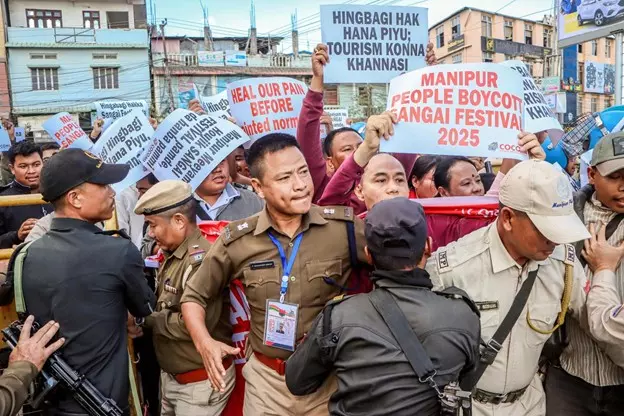
- Home
- India
- World
- Premium
- THE FEDERAL SPECIAL
- Analysis
- States
- Perspective
- Videos
- Sports
- Education
- Entertainment
- Elections
- Features
- Health
- Business
- Series
- In memoriam: Sheikh Mujibur Rahman
- Bishnoi's Men
- NEET TANGLE
- Economy Series
- Earth Day
- Kashmir’s Frozen Turbulence
- India@75
- The legend of Ramjanmabhoomi
- Liberalisation@30
- How to tame a dragon
- Celebrating biodiversity
- Farm Matters
- 50 days of solitude
- Bringing Migrants Home
- Budget 2020
- Jharkhand Votes
- The Federal Investigates
- The Federal Impact
- Vanishing Sand
- Gandhi @ 150
- Andhra Today
- Field report
- Operation Gulmarg
- Pandemic @1 Mn in India
- The Federal Year-End
- The Zero Year
- Science
- Brand studio
- Newsletter
- Elections 2024
- Events
- Home
- IndiaIndia
- World
- Analysis
- StatesStates
- PerspectivePerspective
- VideosVideos
- Sports
- Education
- Entertainment
- ElectionsElections
- Features
- Health
- BusinessBusiness
- Premium
- Loading...
Premium - Events

The Sangai festival was held from November 21 to 30 amid protests by IDPs demanding that they be allowed to return to their homes. File photo
As BJP falters in Manipur, RSS steps in through initiatives such as Sangai Festival 2025, but protesters push harder
In the damp, tense air of Imphal, two contrasting scenes unfolded, painting a portrait of a state at war with itself and with a narrative being imposed upon it.
In one, Rashtriya Swayamsevak Sangh (RSS) chief Mohan Bhagwat, speaking to a gathering of dignitaries on November 20, invoked ancient Sanskrit shlokas, civilisational unity, and the patient, virtuous path to peace. The gist of his speech weighs heavily on the philosophical side.
In the other, the streets echoed with chants of protest, the acrid smell of tear gas hung heavy, and displaced persons from ethnic conflict held demonstrations. Their very presence was a stark rebuttal to Bhagwat’s talk on inherent unity. The trigger was the state government’s decision to proceed with the Sangai Festival 2025, an event they see not as a celebration of culture, but as a cynical political spectacle in a burning house.
This dissonance is the key to understanding the current crisis in Manipur. Bhagwat’s carefully calibrated speech, delivered against the backdrop of the BJP’s failure to reinstall a popular government after the imposition of President’s Rule and the mounting fury over the Sangai Festival, is not an isolated peace offering.
Bhagwat said “Hindu” is not a noun but an adjective, a civilisational identity that seeks to absorb the region’s distinct ethnic and religious tapestry.
For the RSS, it is a strategic move in a long-term project to culturally and politically integrate the north-east into a specific idea of Hindu India. Bhagwat said “Hindu” is not a noun but an adjective, a civilisational identity that seeks to absorb the region’s distinct ethnic and religious tapestry.
Also read: People displaced by Manipur's ethnic violence demonstrate, seeking to return home
The palpable anger on the ground is a direct response to this perceived project, which many see as an attempt to dismantle their unique identities and realign their political allegiances.
Political vacuum
The failure of the BJP to form a government after President's Rule is a telling indictment of its political capital in the state. The party, which once navigated Manipur’s complex political landscape to secure power, now finds itself unable to cobble together a majority. The ethnic violence between the Meitei and Kuki communities has shattered its carefully constructed coalition, exposing the limits of its top-down political management.
RSS had been watching the drama unfold since May 3, 2025. Now, with the political power vacuum in Manipur, RSS decided to step in, not as a political party, but as something it claims is far grander: a “man-making methodology” and a civilizational unifier.
Civilizational unifier
Bhagwat’s speech reported by the media seems like a masterclass in subtle positioning of RSS’ agenda of civilizational unification.
He begins by addressing the “perceptions and propaganda” against the RSS, a nod to the deep suspicion with which the organisation is viewed in many parts of the north-east, particularly among Christian-majority communities. By claiming the RSS is as incomparable as “the sea, the sky, and the ocean”, Bhagwat elevates it above the grubby realm of everyday politics, presenting it as a natural, organic force.
This is crucial. When elected governments fail, the RSS positions itself as a transcendent, societal-level actor that can achieve what politicians cannot: unity.
His clarification that the RSS aims to “organise the entire Hindu society, including those who oppose it”, and that it is not about creating a “power centre,” is a disarming rhetorical tactic. However, in the context of Manipur, this is precisely what critics fear—the creation of a unified, majoritarian social bloc that operates parallel to, and often influences, state power.
For the Kuki-Zo tribes, who are predominantly Christian, and for many others, this “organisation” is seen as a direct threat to their religious and cultural autonomy.
Redefining the Hindu
The core of Bhagwat’s ideological outreach is the redefinition of the “Hindu”.
By framing it as a civilizational identity rather than a religious one, he attempts to create a big tent under which the diverse communities of the north-east can be accommodated. He cites Ekam Sat Vipra Bahudha Vadanti (Truth is one, the wise perceive it in many ways) and Vasudhaiva Kutumbakam (the world is one family) to project an image of innate inclusivity.
“Diversity is not a myth. Diversity is the manifestation of inherent unity,” he asserts. And RSS lovers and watchers listen.
Also read: RSS at 100: How Hindu nationalism drew from Mussolini’s fascist model
For many indigenous tribes, their identity is not an adjective of a larger Hindu civilisation; it is a noun, a sovereign, self-defined entity rooted in their own “unique histories”, traditions, and, for many, their new-found Christian or Jewish faith.
This philosophical framing, however, collides with the hard realities of identity politics in the region. For many indigenous tribes, their identity is not an adjective of a larger Hindu civilisation; it is a noun, a sovereign, self-defined entity rooted in their own “unique histories”, traditions, and, for many, their new-found Christian or Jewish faith.
The attempt to recast their identity as a variation of a pan-Indian Hindu civilization is seen not as an embrace, but as an erasure. It is viewed as the ideological wing of a political project that seeks to homogenise India's complex cultural landscape.
Pantomime of normalcy
This is the subtext of the violent protests against the Sangai Festival. The festival, named after the state’s iconic brow-antlered deer, is intended to showcase Manipur’s culture and tourism. But in a state where thousands are still living in relief camps, where villages have been burned, and trust between communities is in tatters, the festival is seen as a grotesque pantomime of normalcy.
The government, led by the Governor and backed by the BJP at the Centre, is seen as more interested in projecting an image of peace and normalcy for a tourism brochure than in addressing the root causes of the violence.
The protesters who attempted to storm the venue see it as a party being thrown on a grave. The tear gas fired at them is a physical manifestation of the state’s refusal to listen to their pain, perfectly illustrating Bhagwat’s own, albeit unintended, point: “Nobody listens to the weak.”
Bridging or dividing?
Proponents of the RSS’s work in the north-east, as highlighted in many media platforms, argue that the organisation has successfully bridged divides by integrating itself into the local social fabric. They point to its work in education, disaster relief, and promoting indigenous tribal languages and culture as evidence of its genuine, non-political service.
This “broke the stereotypes,” the argument goes, by presenting a face of Hindutva that is not antagonistic but accommodating.
The RSS has made significant inroads by aligning with and supporting elements that are amenable to its worldview. However, the critical charge, which fuels the current anger in Manipur, is that this “bridging” has a clear direction: it pulls communities away from their existing religious and cultural orbits (particularly Indigenous faiths and Christianity) and towards the ideological centre of the Sangh.
The help is extended, critics argue, precisely to those who “do not toe the line” of Christian or Islamic dominance, thereby creating new social fissures and deepening existing ones for long-term political gain.
Also read: Why RSS peacekeeping mission in Manipur may worsen crisis
The promise of “Social Harmony” from Bhagwat’s “Panch Parivartan” (Five Key Initiatives) rings hollow when the very definition of that harmony is predicated on accepting a civilisational identity that many reject. His call for “Family Awakening” and “understanding our identity” can easily be interpreted, in this fraught context, as a call for families and communities to rediscover their supposed “Hindu” roots, a project that is viewed with intense suspicion by Christian communities.
Road to nowhere?
Bhagwat and the RSS’s ideal of Sampoorna Samaj ka Sangathan by Sajjan Shakti – the organisation of the entire society through the power of the virtuous. It is a noble-sounding goal. But in the hills and valleys of Manipur, the definition of “virtue” is fiercely contested.
For the RSS, it lies in the rediscovery of a unified Hindu civilisational identity. For the protesters on the street, it lies in the state acknowledging their suffering, ensuring justice, and respecting their distinct identities without subsuming them into a majoritarian project.
The Sangai Festival protests and the political failure of the BJP are not separate issues from Bhagwat’s civilisational sermon; they are two sides of the same coin. One represents the top-down, ideological push for a united, “Hindu” Bharat; the other is the grassroots, furious rejection of that vision by people who see it as a threat to their very survival.
Bhagwat urged patience, saying, “Destruction takes minutes, but construction requires years.” But the people of Manipur are weary of a construction plan that they had no hand in drafting. Until the architects of this plan genuinely listen to the definitions of unity and identity that emanate from the relief camps and the protest sites, rather than just from the shakhas, the road to peace in Manipur will remain long, winding, and paved with tear gas shells.
(The Federal seeks to present views and opinions from all sides of the spectrum. The information, ideas or opinions in the articles are of the author and do not necessarily reflect the views of The Federal)


